The 45th Annual Three Peaks Cyclo Cross Race
Race report by James Lyon
Known all over the world as the most famous and toughest cyclo cross
race around, the Three Peaks Cyclo Cross is a tradition that dates back
to 1961. For decades, Yorkshire’s “Three Peaks” of Ingleborough
(723m/2372ft), Whernside (736m/2414ft) and Pen-y-Ghent (694m/2277ft)
have been a testing ground for endurance events. In keeping with the
event traditions, the rules are very strict. No mountain bikes, no flat
bars wider than 50cm, no tires wider than 35mm. The race is so tough
with such a high potential for serious incident that all competitors
must carry an orange survival bag and a whistle. This ain’t no
hour-plus-a-lap thrash round a muddy field!
 The
race started at 10am (vets and women had an earlier start of 9.30am) at
Helwith Bridge about 2 miles south of Horton-in-Ribblesdale. There was a
neutralised road start for the 3 miles of road up through Horton to a
turning on the left up to a farm called Gill Garth. After that, it was
race on, the track became gravel then grassy moorland and the climbing
started. I got a reasonable start, up in the top 60 or so as the 200+
senior riders wound their way up through Horton. It was like a standard
road race at first except with a proper closed road and full police
escort. Out of Helwith, the bunch turned left and the road flattened
out, there was a synchronised “ker-CHUNK” as 200 riders changed up a cog
simultaneously. Once we hit the lower slopes of Ingleborough, the bunch
thinned out considerably. Mostly rideable early on, the slopes quickly
kicked up in a series of false summits with Simon Fell being so steep
(getting on for 45° in places) that we were forced to use the fencing at
the side of the track to steady ourselves when climbing, bikes over one
shoulder. The going was fairly firm; the weather had been kind in the
previous few days but as we climbed higher, the mist gradually enveloped
us. Riding along one of the false flats near the top, I took off my
glasses as they were useless in that fog. Visibility was down to less
than 5m. I eventually reached the summit, handed the first of 3 race
tags to a marshal then started the descent. Rideable in bits at first,
the gradient gradually eased off, we cleared the mist and then it was a
fast blast over bumpy grass down to the road at Cold Cotes. There were a
few rocky sections to catch out the unwary but I made it down in one
piece, still more or less in the top 60. The
race started at 10am (vets and women had an earlier start of 9.30am) at
Helwith Bridge about 2 miles south of Horton-in-Ribblesdale. There was a
neutralised road start for the 3 miles of road up through Horton to a
turning on the left up to a farm called Gill Garth. After that, it was
race on, the track became gravel then grassy moorland and the climbing
started. I got a reasonable start, up in the top 60 or so as the 200+
senior riders wound their way up through Horton. It was like a standard
road race at first except with a proper closed road and full police
escort. Out of Helwith, the bunch turned left and the road flattened
out, there was a synchronised “ker-CHUNK” as 200 riders changed up a cog
simultaneously. Once we hit the lower slopes of Ingleborough, the bunch
thinned out considerably. Mostly rideable early on, the slopes quickly
kicked up in a series of false summits with Simon Fell being so steep
(getting on for 45° in places) that we were forced to use the fencing at
the side of the track to steady ourselves when climbing, bikes over one
shoulder. The going was fairly firm; the weather had been kind in the
previous few days but as we climbed higher, the mist gradually enveloped
us. Riding along one of the false flats near the top, I took off my
glasses as they were useless in that fog. Visibility was down to less
than 5m. I eventually reached the summit, handed the first of 3 race
tags to a marshal then started the descent. Rideable in bits at first,
the gradient gradually eased off, we cleared the mist and then it was a
fast blast over bumpy grass down to the road at Cold Cotes. There were a
few rocky sections to catch out the unwary but I made it down in one
piece, still more or less in the top 60.
Back onto road and I was on the fastest section of the course, the
fast downhill to the top of the village of Ingleton. Just as I turned
out of Ingleton and began the road climb that would take me to Whernside,
I hooked up with a fast-moving bunch of about 8 and we made good time to
the next Peak. Whernside is the highest of the three but the climb is so
steep that it’s actually quite short. Through a farmyard with a neutral
feed zone then it was carry-time again as the trail kicked upwards into
the clinging mist and drizzle. Carved in a series of packed rock steps,
Whernside is just a slog but it’s over fairly quickly and the summit is
just a long ridge with a sandy surface, easily rideable if you ignore
the big drop sucking at your heels on the right hand side. I handed the
second tag in to the group of marshals sheltering under their umbrellas
and began the descent. This is a broad stone-flagged surface, similar to
the packhorse trails in the Peak District. The rain had made the surface
treacherously slippery though and there were a lot of walkers and fell
runners out too so the trails were quite congested in places. The slope
is quite gradual though and it made a nice (if very bumpy) descent,
which brought us out right by the sweeping curve of the famous
Ribblehead viaduct. By now the weather had picked up considerably and it
was onto the road again for the 6 miles of tarmac down to the final
gauntlet of Pen-y-Ghent. This track is unique in that it is the same
route up and down the hill, which makes it a considerable challenge to
climb and descend while avoiding other riders descending and climbing!
The lower slopes of PYG are easy, even considering how tired all the
racers are by this point. Mostly wide gravel double track, with just a
few small rocky outcrops, it was a simple enough task to stick to one
side of the track while watching all the fast boys hurtle down on the
other side. By this point they were about an hour ahead of me. I got to
the gate where the main track carries straight on and the summit track
forks right. The sun had come out in full force now and depressingly, I
could see the summit looming over me. PYG may be the smallest of the
Three Peaks but it’s also by far the longest climb; it goes on forever
in a series of big sweeping S-bends. Mostly rideable at first, the track
soon became too narrow to ride safely – a mix of factors including
riders descending, walkers being on the track and the heat made it
easier to walk with alternate sections of pushing and carrying. I
recognised a good percentage of riders on their way down and we swapped
words of encouragement. After what seemed like an eternity, I got to the
top, rode the final 200m to the summit and handed in the last tag. I was
exhausted but still had the descent to cope with and there were still
hundreds of riders coming up. I ran the first part of the descent, over
two large rocky sections then hopped back on the bike and started down.
After only a couple of minutes, I could smell the brakes as they heated
up. I was swerving past climbing riders and walkers, trying to avoid the
drainage gullies and trying to make up time lost on the climb when
disaster struck. The rear wheel clipped the lip of one of the drainage
channels, I was simply too tired to bunnyhop it properly and seconds
later I felt the rear tyre slipping and flapping. I stopped, flipped the
bike upside down and dropped the wheel out, at the same time grabbing
the spare tube and gas can from under the saddle. I had the tube
replaced in a matter of seconds but as I inflated it with the gas can,
the tyre popped off the rim and I was forced to partially deflate the
tube, reseat the tyre and use the last of the gas can to get it
re-inflated. It wasn’t enough, the tyre was only at 40psi and I knew I
still had at least 1.5 miles of descent to go. However desperation won
out, I couldn’t be bothered wasting more time by topping it up with the
pump I had and reckoned if I rode carefully, it might just last. It
didn’t. Half a mile later, the tyre had once again pinch flatted. I
replaced the tube again with my second and final spare. I’d only brought
the one gas can so I was forced to use the pump which was sufficient to
get up to about 40psi again. At this point, luck finally stepped in –
there was a guy 200m further down the trail with a track pump in his
rucksack, obviously a helper to one of the other riders. I rode down,
stopped by him and he very kindly lent me the track pump to top up the
tyre pressure. Back up at 90psi but with 20minutes lost to two puncture
repairs, I jumped back on the bike and sprinted off down the last mile
of gravel track, dodging a few more riders who were just starting the
climb.

I turned out of the track back onto the road, jumped the curb and
sprinted off, trying to make up as much time as possible. By this point,
most people looked shattered and were simply trying to finish so I
managed to pass a few riders as I came into Helwith Bridge, round the
final turn and into the field at the end. I’d originally been hoping to
finish in less than 4hrs but the punctures put paid to that idea. I
finished 124th out of the total 400 starters and 79th out of the 167 in
the Senior category in a time of 4.20.31.
The winner, Rob Jebb (his 6th consecutive Three Peaks win, equalling
the record of Tim Gould in the 80’s) had finished in a shade over 3hrs!
This was an amazing race, quite unlike anything else I’ve done and
left me feeling as tired as at the end of most of the 24hr mountain bike
races I’ve competed in. Nothing in training can replicate the Three
Peaks; it’s a unique event on the biking calendar with an atmosphere all
of it’s own. Further information on the race can be found at
http://www.3peakscyclocross.org.uk along with photos and
results from the last few years.
|